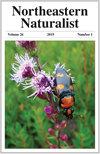在宾夕法尼亚州的森林和草地上,小型哺乳动物将入侵植物的大部分果实视为低质量的饲料
IF 0.5
4区 环境科学与生态学
Q4 BIODIVERSITY CONSERVATION
引用次数: 0
摘要
摘要:入侵植物通常会彻底改变食物网。小型哺乳动物群落可能会受到入侵植物的极大影响,这些植物通常为捕食者提供掩护。此外,研究较少的潜在影响是小型哺乳动物将入侵植物作为食物资源的可能性。以美国宾夕法尼亚州5种常见入侵灌木和1种原生灌木的果实为样本,定量分析了小哺乳动物的放弃密度。该研究连续两年在11月进行了两次48小时的实验,在装有Panicum miliaceum (Proso Millet)和沙子的桶中,对小型哺乳动物提供不同组合的灌木水果。虽然采食活动存在一定程度的年际差异,但在不同水果种类之间和不同生境之间存在显著差异。入侵灌木Berberis thunbergia(日本小檗)、Ligustrum vulgare(欧亚女贞)和Rhodotypos scandens(赤珠)的果实在两种生境中均未被小型哺乳动物明显捕食。而木本藤本植物Celastrus orbiculatus(东方苦甜)在森林和草甸中都很容易被食用。入侵灌木秋橄榄(Eleagnus umellata,秋橄榄)的果实仅在草甸生境中被采得,而本地灌木林达(Lindera benzoin,香灌木)的果实则在森林中被适度采得。通过这个实验,我们能够得出结论,本研究中包括的大多数木本植物提供的果实具有有限的感知益处。然而,东方苦甜和秋橄榄可能是影响东北森林和草甸生态系统中小型哺乳动物觅食模式的重要例外。本文章由计算机程序翻译,如有差异,请以英文原文为准。
Small Mammals Perceive Most Fruits of Invasive Plants as Low-Quality Forage in a Pennsylvanian Forest and Meadow
Abstract - Invasive plants often drastically alter food webs. Small-mammal assemblages may be greatly impacted by invasive plants, which often provide cover from predators. In addition, a less-studied potential impact is the possibility that small mammals use invasive plants as a food resource. We quantified small mammal giving-up densities (GUDs) by offering fruits of 5 common invasive shrubs and 1 native shrub in adjacent meadow and forest habitats in Pennsylvania. The study ran for two 48-hour sessions in November in 2 consecutive years with different combinations of shrub fruits available to small mammals within buckets that also contained Panicum miliaceum (Proso Millet), and sand. While some degree of differences in foraging activity could be accredited to annual variation, significant differences in GUDs among fruit species and between habitats were detected. The fruits of the invasive shrubs Berberis thunbergia (Japanese Barberry), Ligustrum vulgare (Eurasian Privet), and Rhodotypos scandens (Jetbead) did not appear to be significantly foraged on by small mammals in either habitat. However, the woody liana Celastrus orbiculatus (Oriental Bittersweet) was readily consumed in both the forest and meadow. Fruits of the invasive shrub Eleagnus umbellata (Autumn Olive) was favored but only in meadow habitat, while fruits of the native shrub Lindera benzoin (Spicebush) were moderately foraged in the forest. Through this experiment, we were able to conclude that most woody plants included in this study offer fruits with limited perceived benefit. However, Oriental Bittersweet and Autumn Olive may represent important exceptions that could be influencing small-mammal foraging patterns in northeastern forest and meadow ecosystems.
求助全文
通过发布文献求助,成功后即可免费获取论文全文。
去求助
来源期刊

Northeastern Naturalist
环境科学-生态学
CiteScore
1.10
自引率
0.00%
发文量
42
审稿时长
18-36 weeks
期刊介绍:
The Northeastern Naturalist covers all aspects of the natural history sciences of terrestrial, freshwater, and marine organisms and the environments of the northeastern portion of North America, roughly bounded from Virginia to Missouri, north to Minnesota and Nunavut, east to Newfoundland, and south back to Virginia. Manuscripts based on field studies outside of this region that provide information on species within this region may be considered at the Editor’s discretion.
The journal welcomes manuscripts based on observations and research focused on the biology of terrestrial, freshwater, and marine organisms and communities as it relates to their life histories and their function within, use of, and adaptation to the environment and the habitats in which they are found, as well as on the ecology and conservation of species and habitats. Such studies may encompass measurements, surveys, and/or experiments in the field, under lab conditions, or utilizing museum and herbarium specimens. Subject areas include, but are not limited to, anatomy, behavior, biogeography, biology, conservation, evolution, ecology, genetics, parasitology, physiology, population biology, and taxonomy. Strict lab, modeling, and simulation studies on natural history aspects of the region, without any field component, will be considered for publication as long as the research has direct and clear significance to field naturalists and the manuscript discusses these implications.
 求助内容:
求助内容: 应助结果提醒方式:
应助结果提醒方式:


